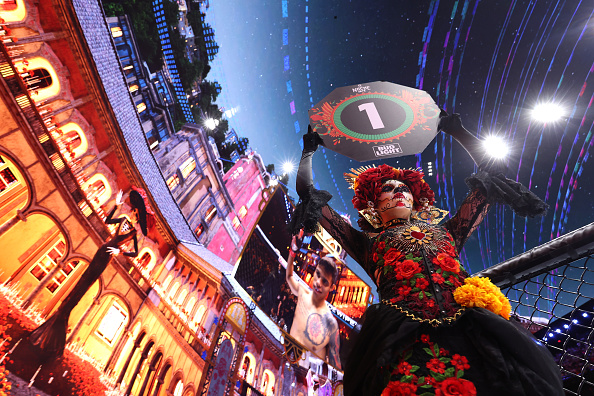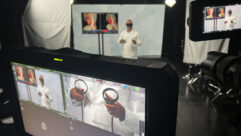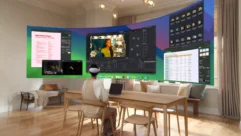
The Sphere keeps blazing new trails with its futuristic AV platform. Its first deployment as a stadium was a breathtaking look at the future of mixed reality sporting experiences, where sports and worlds converge. The UFC 306 at RIYADH SEASON NOCHE UFC held on September 14 at Sphere in Las Vegas set a number of records, including highest-grossing UFC event of all time and highest-grossing single event at Sphere, with a gate of $22 million and a sold-out crowd of 16,024. But for our purposes, it also rewrote the roadmap for next-level fan experiences with its combination of spectacular storytelling visuals, live sports, and grand-scale audio.
To understand the financial potential of this type of fan experience, UFC 306 at RIYADH SEASON NOCHE UFC bested the previous gross sales landmark: UFC 205: ALVAREZ VS MCGREGOR at Madison Square Garden in New York made $17.7 million; the Sphere event pulled in approximately 25% more. As Sphere’s highest-grossing event, it also made the point that Sphere and sports belong together. Reportedly 86% of the ticket buyers originated from outside of Nevada, reaffirming UFC’s power as a live event attraction and also demonstrating Sphere’s drawing power for sporting events.
One of the most striking aspects of the UFC event was the way Sphere’s giant canvas was used as storytelling. UFC 306 at RIYADH SEASON NOCHE UFC celebrated Mexican Independence Day weekend and served as a passionate tribute to the Mexican people and their culture, as well as a celebration of their fighting spirit and contributions to combat sports. UFC 306 featured the premiere of the film For Mexico, For All Time as told in six 90-second chapters woven into the event presentation shown on the interior display plane of Sphere – the world’s highest resolution LED display – throughout the Pay-Per-View portion of the event, with each chapter focusing on a different period in Mexican history and its influence on the makeup of Mexican identity. The film was created by Carlos López Estrada, produced by Valerie Bush for Antigravity Academy, and coproduced by Emmy-Award winning Nexus Studios. In this imagining, fans experienced eagles circling the Octagon from nearly 400 feet above, fights occurred against a backdrop of an ancient temple and under a futuristic Mexican skyline.
The innovative use of production technology capitalized on Sphere’s state-of-the-art audio and video capabilities to deliver a live experience never before witnessed in the history of sports, and supporting unique broadcast and pay-perview features.
For example, in addition to the context-setting film, the production utilized technology in other fan-friendly ways. The Live Fighter Heart Rate Tracking tracked, analyzed, and displayed select fighters’ heart rates on Sphere’s interior media plane and simultaneously on the broadcast—the first time such heart rate-tracking technology has been used for combat sports.
UFC also made use of Sphere’s “pass-through” lighting capability by installing 80 light fixtures behind Sphere’s interior media plane that projected light on the Octagon to replace UFC’s traditional hanging lighting truss. Sphere’s audio team made novel use of Sphere Immersive Sound powered by HOLOPLOT by deploying audio beams in 360 for the first event held in the round at Sphere.

In lieu of not being able to rig mics over the Octagon due to the absence of the traditional UFC lighting truss, UFC installed Shure Digital Microphone Array Technology, an innovative audio product not yet available on the market, under the four camera platforms on the Octagon.
In other audio innovations, UFC and Sphere’s audio team worked together to provide force feedback to the venue’s haptic seats based on the action in the Octagon using both automated and manual cues—a first for a UFC event and the first time Sphere used haptic effects that were triggered by physical action and translated into haptic feedback in real time. Additionally, total of 32 directional microphones were installed in the seating area of the venue to pick up ambient sounds, and five “thump” mics were placed under the Octagon to power Sphere’s haptic seating experience.
UFC utilized the LiveVoice app to provide event attendees with the option to listen to four live streaming audio channels featuring Spanish, English, Red Corner, and Blue Corner commentary via their personal cellular devices. This marked the first time that fans in attendance were able to listen to live audio of an entire UFC event in Spanish.
To capture all the action, UFC utilized 48 cameras, including: four high-speed cameras; seven RF (wireless) cameras; one high-frame rate Fletcher Nucleus camera inside the Octagon integrated into the fence padding; one Navcam four-point cable camera with a Sony HDC-P50 camera; two Trinity hybrid camera stabilized systems; and two MovieBird 45 Techno Crane systems.
Due to the complexity of the event, UFC used six mobile units to produce UFC 306 for broadcast partners around the world, including the first 1080p native production and transmission of a UFC event by ESPN in the U.S.
Four unique transmissions to Australia, New Zealand, Canada, and France were produced live from a single control room at the Broadcast Operations Center at UFC APEX in Las Vegas.
The broadcast included the first use by UFC of TAIT’s Automated Camera System to capture wide shots and convey the grandeur and fully immersive visual environment of Sphere’s 160,000 sq. ft. and 16K x 16K resolution interior media plane for viewers watching the broadcast on television.

Each chapter of the original film For Mexico, For All Time and the fighter features were transmitted in four separate languages for UFC’s international broadcasts, including English, Spanish, French Canadian, and Portuguese. A custom-curated live feed featuring fighter statistics and information was integrated seamlessly into Sphere’s LED media plane during the “worlds” of the original film that served as the setting for each bout.
UFC’s technology partner, Combat IQ, applied AI computer vision stat tracking to standard broadcast cameras to capture new striking statistics such as strike target zones, left punches vs. right punches, strikes by stance, and other advanced metrics that were displayed on Sphere’s interior media plane during the bouts.
And a final technology element came from the thousands of cellphones as fans shared their POV of the event worldwide.
UFC CEO Dana White told ESPN that the UFC spent $20 million on the event and employed a staff of more than 500 people to pull it off. He explains that when he attended the U2 concert at Sphere last year he formed the vision for this pioneering, spectacular, and completely unique event.
“What UFC was able to do so beautifully was enhance the action in the Octagon without distracting from the main events,” Joel Fisher, executive vice president of Marquee Events and Operations at Madison Square Garden Entertainment, told ESPN.
ESPN devoted a large and appropriate amount of ink to the event, throwing in the value of gore, as when the reported worst forehead cut in MMA history was blown up into a 50-foot closeup.
White also shared some important AV details with ESPN, explaining in part how the budget went from an anticipated $8 million to the final $20 million. One issue was the Octagon lighting. The simple absence of the conventional truss took the kind on site innovation integrators often do to a new scale. After trial and error, an unnamed engineering group designed a system to go behind the screens to take advantage of the gaps in the LED screens that were already there to support audio playback. Among the other costs, the sheer demands of resolution led to days of rendering content, according to UFC chief content officer and executive producer Craig Borsari. “That’s not cheap,” he understated to ESPN.
Beyond the specific details, ESPN rightly asked whether UFC has set the bar for the wealthiest franchises in sports; several highprofile sports figures chimed into the article to agree with the power of uniting sports and “worlds.” It’s something that has been tried in limited ways but never with the technological power and scale of Sphere. The merging of content creation talent, athletic talent, and sheer AV horsepower holds limitless potential. This will in turn affect how stadiums are used, upgraded, and designed, especially from an AV perspective. “It’ll take the NBA or one of these companies with a ton of money [to do it],” White told ESPN. “But we showed everybody tonight what’s possible. You can do more than concerts here. So, who’s next?”










